See Guangzhou again-Sun Yat-sen Memorial Hall
Walking time: 2020.7
D1:
Walking method: Self-driving by plane (Nanjing-Guangzhou)
Walking route: Nanhai Temple (Tour time: 1.5 hours, ticket: 15 yuan) Lingnan Impression (Arrived at 16:40, closed at 5 o'clock, unable to enter) Guangzhou University Town Science and Technology Museum (appearance) Foraging on Beijing Road
Check-in: CityNote Sinoo Hotel (Guangzhou Beijing Road Dafosi Park Front Subway Station Branch)271 yuan/standard room
D2:
Walking method: walking, renting
Walking routes: Lu Xun Memorial Hall (1.5 hours, online reservation in advance, tickets are not available), Guangdong Museum (1.5 hours, online reservation in advance, tickets are not available), United Bookstore
Check-in: Beijing Road Sino Hotel
D3:
Walking methods: walking, subway
Walking routes: Nanyue Palace Museum (1.5 hours, no tickets), Yuexiu Park (2 hours, online reservation in advance, no tickets), Guangzhou Museum, Yuehai Tower Foraging
Check-in: Jinzhou Hotel (Guangzhou Yuexiu Park Subway Station Branch) 207 yuan/standard room
D4:
Walking method: walking, renting
Walking routes: Sun Yat-sen Memorial Hall (free tickets for medical staff), Beijing Road, Tao Tao Ju foraging
Check-in: Guangzhou Huamao Guangfu Cultural Hotel 151 yuan/standard room
D5:
Walking methods: bus, taxi, subway, plane (Guangzhou-Nanjing)
Walking route: Shangxia Ninth Street, Xiguan Dawu, Liwan Lake Park, Xintai Le Dining
D4:
Zhongshan Memorial Hall
Address: Dongfeng Middle Road, Yuexiu District, Guangzhou
Admission: 10 yuan (free for medical staff)
There are some places in the journey plan that you clearly want to go, so you will plan the time and even book a hotel nearby. Some itineraries are improvised due to changes. Sun Yat-sen Memorial Hall belongs to the latter. Because a friend drove to see me, it would take less than an hour to drive to Guangzhou City. While waiting, I just had time to visit the Sun Yat-sen Memorial Hall. The hotel is a ten-minute walk from Sun Yat-sen Memorial Hall. The Sun Yat-sen Memorial Hall has gates to the southeast, northwest, but now tourists can only enter from the south gate of Dongfeng Middle Road. Entering the south gate, you will find on the square. The overall layout of the Sun Yat-sen Memorial Hall surrounded by green trees is square, facing north to south. In the center of the memorial hall, there is a white granite base among the clusters of flowers, and on the base stands a full-body bronze statue of Sun Yat-sen. On both sides of the bronze statue, green cypresses and flowers hug each other.
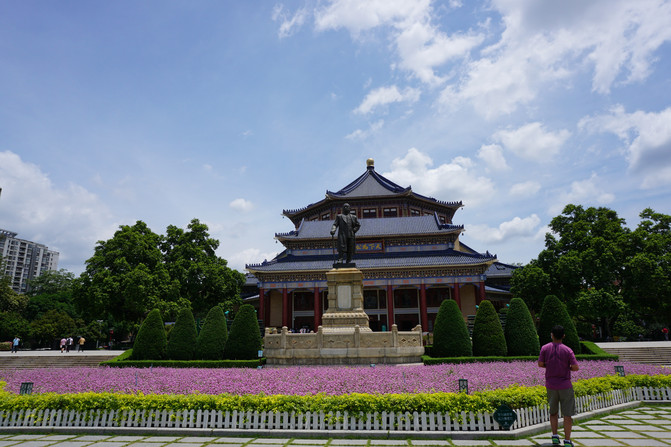
The pink and red flowers in the square are blooming

Across a wide square with beautiful grass and greenery, there is the gate building of the Sun Yat-sen Memorial Hall on one side of the road. The gate building is similar to the front gate of the Sun Yat-sen Mausoleum in Nanjing that I am familiar with. It has three house-style three-hole arches. The top of the door has multiple eaves and overlapping pavilions. The cornices roll out. The royal blue glazed tiles look solemn and gorgeous under the bright sunshine.
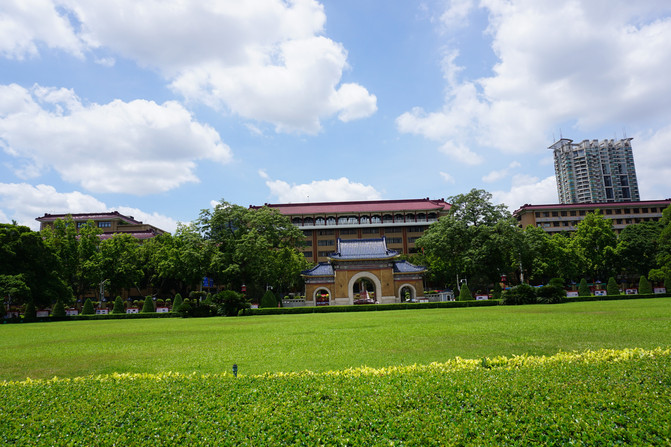
There is a Chinese watch on both sides of the square in front of the Sun Yat-sen Memorial Hall. The beautiful table is majestic and handsome, high into the sky, and the top of the column is surrounded by auspicious clouds, making it look extraordinary and solemn.
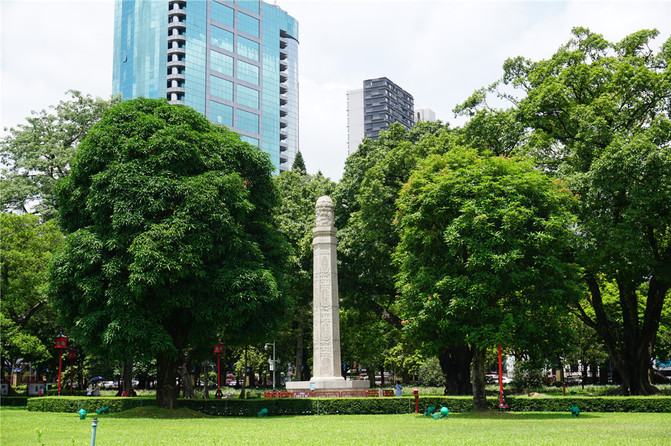
The main hall of Sun Yat-sen Memorial Hall is a grand and magnificent octagonal palace-style building. There are eight eye-catching red stone pillars in front of the door, with layers of cornices and angled corners, and supporting the central octagonal stone. In the center of the top of the mountain with double eaves hangs a large lacquer gold plaque with a blue background and red edges. On it is written by Sun Yat-sen with the powerful four characters "The world is for the public".

On both sides of the main entrance of the memorial hall, two tripods fired in 1929 are placed.

Under the eaves of the front, there are eight vermilion water mill stone pillars inside and outside. The painted water-grinding stone rice arches, flower beams and parquet ceilings are finely crafted and colorful.

The glass-inlaid bronze chandelier hanging under the eaves of the main entrance hangs in the middle of the tall corridor, reflecting the carved red door, making the hall more magnificent and ancient.

The cornerstone and the stele contain the birthday of the memorial hall. Tickets are required to enter the memorial hall, and medical staff certificates are used to enter and visit it for free.

Check your tickets and enter the Memorial Hall, and enter the General Assembly Hall a few steps away.

The Great Hall in the Memorial Hall.
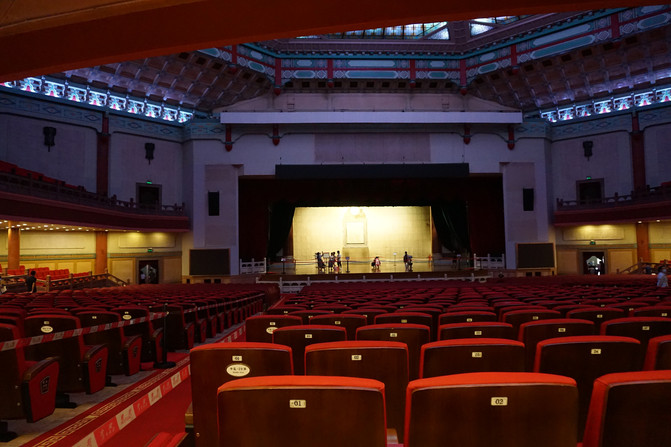
The auditorium is divided into two floors, upstairs and downstairs, with 8 stairs, 11 entrances and exits, and a total of 5000 seats. Such a large hall cannot see a single pillar. This is an ingenious design by the outstanding architect Lu Yanzhi. Only after reading Baidu did I understand the design principles and ideas: the designer used four large pillars (the pillars are located in the surrounding walls) to support four large-span steel trusses, like an open umbrella, forming a huge Arch roof. The arched roof supports eight main trusses to form an octagonal pavilion.

There is a large glass skylight in the middle level of the top of the hall, through which light can enter the hall. The lower layer is an oblique grid in moire color for decoration. Because of the clever design, it gives people a new, spacious and bright feeling. Coupled with the clever combination of Chinese and Western architectural details, the hall has clear lighting, magnificent red colors and resplendent decorations.

There is a wide stage in the middle, so it is an important place for large-scale gatherings and performances in Guangzhou City. It has witnessed many historical events in Guangzhou.

On one side of the stage is the famous "Prime Minister's Will".

Outside the Great Hall, exhibitions in multiple sections were held in the main building relying on corridors. The first chapter is "Beautiful City", which introduces the history of the Sun Yat-sen Memorial Hall from the Presidential Palace to the Memorial Hall.

The first "Ancient City of South Guangdong, Pearl of a Millennium" introduces the famous historical city of Guangzhou with maps, pictures and text.

The second picture,"Military and Political Place, the Site of the Presidential Palace", introduces that the memorial hall was built with funds by the people of Guangzhou and overseas Chinese to commemorate Dr. Sun Yat-sen. Construction started in January 1929 and was completed in November 1931. This was originally the former site of the Presidential Palace when Dr. Sun Yat-sen became interim president in Guangzhou in 1921.

Original historical works

"Urban Landmark, Memorial Space" introduces the design of the memorial hall that is symmetrically distributed along the central axis like the Forbidden City. It breaks through the traditional shape of "front stele and back hall" and is a perfect combination of traditional Chinese architectural style and Western architectural structure. In the 1930s, Sun Yat-sen Memorial Hall and Sun Yat-sen Monument became the spatial coordinates of modern Guangzhou.
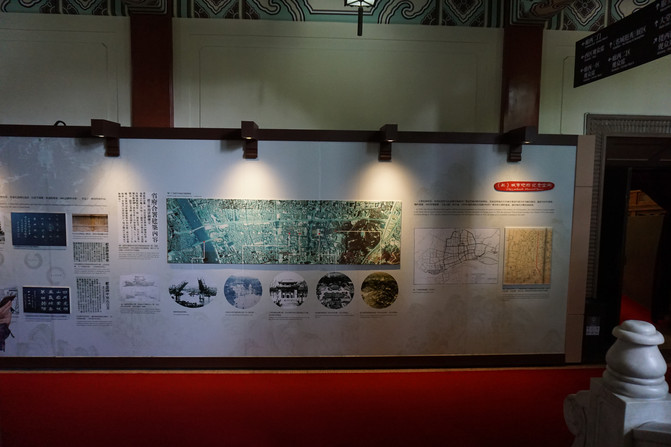
Climbing up the stairs, the details of the building combine Chinese and Western, making it particularly elegant and magnificent.

The corridor on the second floor is surrounded by introduction display boards about the Sun Yat-sen Memorial Hall. There are various commemorative medals on the long table in front of the window, and interested tourists are lining up to stamp them.

The fourth chapter,"Architectural Treasures", introduces in detail the peak work of the Sun Yat-sen Memorial Building.

The window displays the design of Sun Yat-sen Great Hall, documents during the construction process, and a photo of the opening ceremony of the Guangzhou Memorial Hall on the National Day of the 20th Republic of China.

The designer Lu Yanzhi is a great designer. He designed the Sun Yat-sen Mausoleum in Nanjing, which I am familiar with, and the Sun Yat-sen Monument that I saw on Yuexiu Mountain in Guangzhou yesterday. He studied at Tsinghua University Preparatory School in the United States and later went to study at Cornell University in the United States. Therefore, his works are a blend of Eastern and Western styles, and the overall layout adopts a combination of Chinese and Western styles, and foreign is used for Chinese use.

Look at the square from the corridor on the second floor and experience this historical building from another angle. There is a white granite platform in front of the main entrance stone steps. On the base stands a bronze full-length portrait of Sun Yat-sen, with cypresses and flowers planted on both sides. The front square is open and green, surrounded by high red cotton trees and shaded by green banyan trees, making it peaceful and solemn. In front of the square is a gate building with blue glazed tiles on the top of a round arch.

The design of the Sun Yat-sen Memorial Hall is introduced in detail with a drawing board on the corridor, from the overall layout and conception, to the comparison and reference of Chinese and Western buildings, as well as the local details of the building.

It can be seen from this simple plane dot line diagram and the overhead photo that there are a flagpole and a cloud and crane watch on the north and south axes of the memorial hall, and the east and west squares, which are thought to be symmetrical respectively. Continuing north of the memorial hall is the Zhongshan Monument and the Zhenhai Tower on Yuexiu Mountain, which is the traditional central axis of Guangzhou's city. The Sun Yat-sen Memorial Hall is located on this central axis and has become an important part of the historical backbone of Guangzhou's city and a major urban landscape symbol.
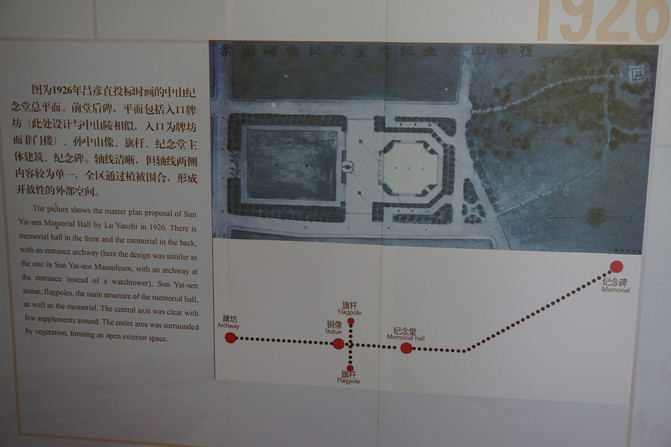


A comparative introduction of the gate building of Sun Yat-sen Mausoleum in Nanjing and the gate building of Sun Yat-sen Memorial Hall

The architectural details such as the porch, steeple, platform base, roof, and sumizuo are introduced in detail in words and pictures.



Detailed introduction to the spine beast and Wadang.

The architecture of the memorial hall absorbs the excellent elements of traditional Chinese architecture, and this quality is reflected from the detailed decoration of the eaves and corners of the house.

Comparison of world architecture, reference

After introducing the main building and the annex building

Leaning against the window on the second floor and looking at the square on the north side, the hill outside the north gate is Yuexiu Mountain that I visited yesterday.

The two-story building surrounded by green trees is an annex to the Sun Yat-sen Memorial Hall.
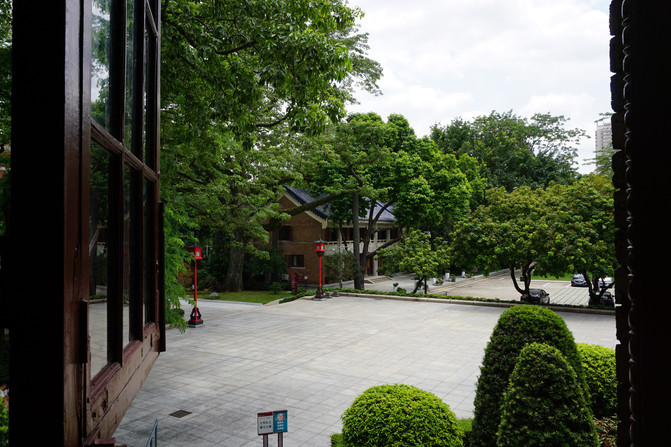
Introduction to "The Great Man of the Century-Sun Yat-sen, the Pioneer of China's Democratic Revolution"




It introduced the institutional history of Sun Yat-sen Memorial Hall and the major activities held here.

After visiting the display on the second floor, we return to the first floor

Come outside the courtyard and look at the memorial hall from another angle. The scattered vegetation sets off the building, with harmonious and beautiful colors.

Enjoy it from the side

Look at the building quietly from the north side of the building. On the north side, you can observe it quietly because there is no interference from tourists: a blue glazed tile roof, an octagonal peaked giant roof in the center of the building, and a shining gold roof above the giant roof. Four palace-style double-eaves Xieshan buildings, front, left and right, are surrounded by the octagonal peak, like four-layered dragon ridges, forming a whole. The central white granite stone is the base and steps, the light blue marble is the dado, the milky yellow tile is the wall body, and the purple-red water-mill column is covered with a royal blue glazed tile roof. The pillars are decorated with ethnic colored paintings and patterns, which are resplendent. Whether it is the architectural level or the color level, it is magnificent and solemn, and it is layered and agile.

Road signs in the garden

On the north side of the memorial hall, there are two annex buildings, one east and one west. The annex building in the northeast corner is now the office space-Guangzhou Sun Yat-sen Memorial Hall Management Center.
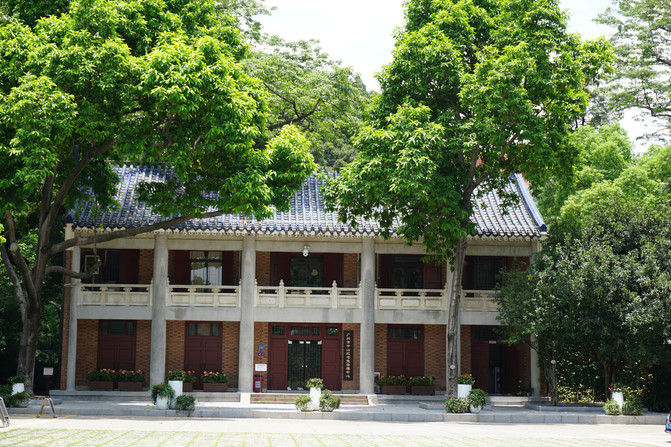
In addition to large green lawns, the park is also planted with flowers and trees such as kapok, white lotus, osmanthus, and Hexiao.

On the west side of the management office near the north gate, there is a 300-year-old kapok tree, which is Guangzhou's "kapok king". In the middle of the "Kapok King", left and right branches stick out to both sides, just like a mother opening her arms and stretching her arms to welcome her children.

In order to better protect the branches of this kapok king tree, a support more than ten meters high was specially erected.

There is a white plum tree in the southeast and southwest corners of the memorial hall. They are evergreen all year round and have huge green crowns like pavilions, like two tall and brave guards guarding here. They were planted during the foundation laying and completion of the memorial hall, and spent more than half a century of bumpy years with the memorial hall.

I spent more than an hour walking around here, seeing the magnificent and ingenious buildings, and learning about history and architecture through the exhibition. You can gain a lot without knowing it, and it is a pleasant textbook.

The time was just right, and my friend arrived and took me on a journey of foraging.
Previous Article:Mulianzhuang Hotel Huadu, Guangzhou, immersive experience of a vacation without going abroad
Next Article:Parent-child tour in Guangzhou, taking your children to visit Sheraton Nansha Yuexiu Hotel
